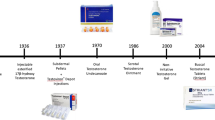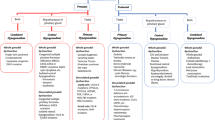Abstract
The relation between supraphysiologic circulating testosterone levels and prostatic diseases is unclear and difficult to study in men. Animal models may be advantageous. Based on a pilot study, testosterone enantate 50 mg (n=12) or 25 mg (n=12) was administered to guinea-pigs intramuscularly every 3 weeks, for either 7 or 14 months. The histopathology of the prostate was described. Epithelial hyperplasia was found in 14/21 animals receiving testosterone and in 7/12 very old animals, but no such changes were found in the sham or castrated animals. Testosterone stimulation seems to induce epithelial hyperplasia, but not cancer, in the guinea-pig prostate.
This is a preview of subscription content, access via your institution
Access options
Subscribe to this journal
Receive 4 print issues and online access
$259.00 per year
only $64.75 per issue
Buy this article
- Purchase on Springer Link
- Instant access to full article PDF
Prices may be subject to local taxes which are calculated during checkout


Similar content being viewed by others
References
Gustafsson O et al. Dihydrotestosterone and testosterone levels in men screened for prostate cancer: a study of a randomized population. Br J Urol 1996; 77: 433–440.
Stattin P et al. High levels of circulating testosterone are not associated with increased prostate cancer risk: a pooled prospective study. Int J Cancer 2004; 108: 418–424.
Mydlo JH et al. A pilot study analyzing PSA, serum testosterone, lipid profile, body mass index and race in a small sample of patients with and without carcinoma of the prostate. Prostate Cancer P D 2001; 4: 101–105.
Jin B, Turner L, Walters W, Handelsman J . Androgen or estrogen effects on human prostate. J Clin Endocrinol Metab 1996; 81: 4290–4295.
Kaufman JM . The effect of androgen supplementation therapy on the prostate. Aging Male 2003; 6: 166–174.
Maini A, Archer C, Wang C, Haas G . Comparative pathology of benign prostatic hyperplasia and prostate cancer. In vivo 1997; 11: 293–300.
Acosta S et al. Neuroendocrine cells and nerves in the prostate of the guinea pig: effects of peripheral denervation and castration. The Prostate 2001; 46: 191–199.
Cockett ATK et al. Relationship of neuroendocrine cells of prostate and serotonin to benign prostatic hyperplasia. Urology 1993; 42: 513–519.
Abrahamsson PA et al. Peptide hormone and serotonin immunoreactive cells in normal and hyperplastic prostate glands. Pathol Res Pract 1986; 181: 675–683.
Abrahamsson PA, Falkmer S, Grimelius L . The course of neuroendocrine differentiation in prostate carcinomas. An immunohistochemical study testing chromogranin A as an ‘endocrine marker’. Pathol Res Pract 1989; 185: 373–380.
Di Sant'Agnese PA . Neuroendocrine cells of the prostate and neuroendocrine differentiation in prostatic carcinoma: a review of morphological aspects. Urology 1998; 52: 121–124.
Bahnemahn R et al. RITA—registry of industrial toxicology animal-data. Guides for organ sampling and trimming procedures in rats. Exp Toxicol Pathol 1995; 47: 247–266.
Benoit B et al. Comparison of residual C-19 steroids in plasma and prostatic tissue of human, rat and guinea pig after castration: unique importance of extratesticular androgens in men. J Steroid Biochem 1989; 32: 695–698.
Carson C, Rittmaster R . The role of dihydrotestosterone in benign prostatic hyperplasia. Urology 2003; 61: 2–7.
Tilley WD et al. Effects of ageing and hormonal manipulations on the level of oestrogen receptors in the guinea-pig prostate. J Endocrinol 1987; 112: 139–144.
Horsfall D et al. Age-related changes in guinea pig prostatic stroma. Lab Invest 1994; 70: 753–763.
Di Sant'Agnese, Davis N, Chen M, Jensen K . Age-related changes in the neuroendocrine cell population and the serotonin content of the guinea pig prostate. Lab Invest 1987; 57: 729–736.
Bonkhoff H . Neuroendocrine cells in benign and malignant prostate tissue: morphogenesis, proliferation, and androgen receptor status. Prostate 1998; 8 (Suppl): 18–22.
Acknowledgements
We acknowledge animal keeper Birgitta Klefbom, Department of Animal Physiology at our university for having taken good care of the experimental animals, providing information on behaviour and administration of testosterone.
Author information
Authors and Affiliations
Corresponding author
Rights and permissions
About this article
Cite this article
Acosta, S., Dizeyi, N., Feinstein, R. et al. Long-term testosterone stimulation induces hyperplasia in the guinea-pig prostate. Prostate Cancer Prostatic Dis 7, 227–231 (2004). https://doi.org/10.1038/sj.pcan.4500744
Received:
Revised:
Accepted:
Published:
Issue Date:
DOI: https://doi.org/10.1038/sj.pcan.4500744
Keywords
This article is cited by
-
Cyclooxygenase-2 activates EGFR–ERK1/2 pathway via PGE2-mediated ADAM-17 signaling in testosterone-induced benign prostatic hyperplasia
Inflammopharmacology (2023)
-
Effects of testosterone replacement on serotonin levels in the prostate and plasma in a murine model of hypogonadism
Scientific Reports (2020)



